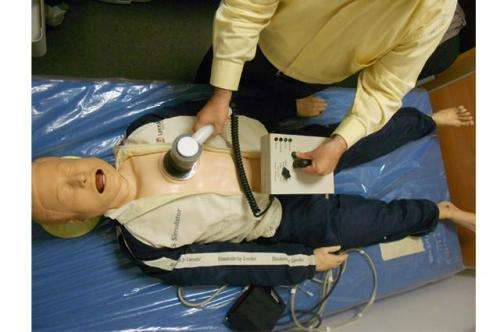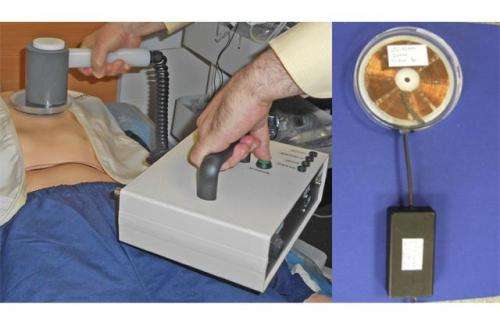Straight to the heart

A battery-less, wirelessly-powered implantable defibrillator for atrial fibrillation is being developed by an international team of researchers in the UK, Venezuela and the US. With the ability to sense the electrical impedance of heart tissue, it could allow electrical treatment of atrial fibrillation to be optimised, reducing pain and required sedation.
Hitting reset
Atrial fibrillation (AF), a disturbance of cardiac rhythm that reduces the heart's output and is associated with a 5-fold increased risk of stroke, is an increasingly common disease. One of the established AF treatment options is electrical cardioversion, which is particularly used for highly symptomatic chronic or persistent AF. In electrical cardioversion, ECG-synchronised electric shocks are applied to the heart to correct its rhythm, by resetting the cardiac cell activation mechanism within the heart.
Shocks can be applied externally or internally, but in either case, hospitalisation is required. In transthoracic cardioversion, the electrodes are placed on the skin, delivering shocks across the chest cavity. This requires anaesthesia, owing to the pain caused by the 150-200 J shocks. Internal cardioversion is also painful, requiring sedation, but in this case, the electrodes are two defibrillation catheters, placed within the heart, delivering shocks of up to 20 J directly across the atrial chambers.
Modern surgically implanted cardioverter defibrillator (ICD) devices can also be configured for AF therapy, delivering their shocks between the coronary sinus and right atrium when AF is detected. However, battery powered implantable units have a finite life, requiring further surgery to replace them. The 20 J of energy required for successful cardioversion, combined with the automation of the ICD, can also significantly impact on the quality of life for the patient, as about 22% of the shocks delivered are unnecessary and occur outside of hospital.

Getting to the heart
As a result, two research priorities in AF electrical cardioversion treatment are: optimisation of the shock waveform, to reduce discomfort and need for sedation; and the development of battery-less, semi-passive, implantable atrial defibrillators to facilitate AF detection/assessment/treatment in a minimal critical care setting.
Pursuing both priorities, the team from the University of Ulster, UK, Universidad Simon Bolivar, Venezuela and Ohio State University in the US, have been working on controlled delivery of electrical cardioversion-level electrical energy to the heart muscle (myocardium), through the skin, without the use of wires.
In their paper in the current issue of Electronics Letters, the team report in-vivo testing of a portable, battery-less, implantable AF treatment defibrillator that also incorporates impedance measurement circuitry. Aimed at use in a clinical setting, their wirelessly-powered impedance compensated passive implantable defibrillator (IC-PIAD) device has been designed to provide a new option for AF treatment, as team member Prof. Omar Escalona explained: "The IC-PIAD technology is a paradigmatically different concept from current ICDs; it provides a passive implantable AF-indicated device without an implanted battery or large capacitor, which is light and small, and offers an alternative for AF treatment without anxiety related discomfort; requiring only light sedation."
Reading rhythms
The in situ impedance sensing allows capture of the electrical impedance spectrum of the myocardium prior to, and between, successive defibrillation attempts. This can potentially be used to allow optimisation of the applied shocks prior to delivery, thereby reducing the energy applied and so the discomfort of cardioversion. In-vivo testing indicates that a fairly significant reduction in the energy required for successful cardioversion should be possible through impedance compensation.
The team believe that further development of the IC-PIAD concept, to incorporate micro-shock sequencing combined with real-time ECG sensing and processing, may eliminate the need for sedation entirely. This kind of treatment could then be brought into the home-healthcare sphere, if supported by reliable e-Health services.
In the immediate future, the team intend to use the IC-PIAD as an enabling technology to facilitate development of novel waveforms and algorithms for improved AF defibrillation. They expect that a first version of the IC-PIAD could be available on the market, for use in patients, in about 5-6 years. Submission as a passive, non-automatic shock delivery, implantable device should shorten FDA approval time, due to the lack of an implanted battery. "All of the main elements of the design have already been separately or jointly tested in acute pre-clinical or clinical trials," said Escalona. "As for the longer term, knowledge derived from this research has already led to European Development funding to develop a new concept in wireless energy supply for driving high-powered medical implants to address a world healthcare problem with advanced heart failure patients awaiting heart transplant."
More information: "Impedance compensated passive implantable atrial defibrillator." P.R. Walsh, et al. Electronics Letters, Volume 50, Issue 17, 14 August 2014, p. 1192 – 1193. DOI: 10.1049/el.2014.1872 , Print ISSN 0013-5194, Online ISSN 1350-911X
Journal information: Electronics Letters
Provided by Institution of Engineering and Technology
This story is published courtesy of Electronics Letters. For additional Electronics Letters news and features visit theiet.org/eletters.

















